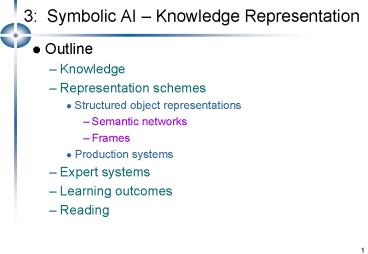3: Symbolic AI Knowledge Representation PowerPoint PPT Presentation
1 / 18
Title: 3: Symbolic AI Knowledge Representation
1
3 Symbolic AI Knowledge Representation
- Outline
- Knowledge
- Representation schemes
- Structured object representations
- Semantic networks
- Frames
- Production systems
- Expert systems
- Learning outcomes
- Reading
2
Knowledge
- Knowledge vital to intelligence
- 2 types of knowledge
- Declarative
- Procedural
- Also
- Domain-specific
- Domain-general
3
Representing knowledge
- Need to get knowledge from (human?) source
- Represent it in a form usable by a machine
- Need to represent
- Facts
- Relationships between facts
- Property inheritance
- All men are mortal
- Socrates is a man
- Socrates is mortal
- Procedural knowledge
4
Knowledge representation schemes
- Need to be
- Expressive
- Different types of knowledge
- Different levels of knowledge
- Specific facts
- Generic information
- Clear
- Effective
- Infer new knowledge from old
- Efficient
- Explicit
- Explanation/justification
5
Semantic networks
Collins Quillian (1969)
isa
6
Semantic nets - reasoning
- Networkdata
- Reasoning traverse arcs to identify
relationships - Collins Quillian (1969)
- Sentence verification task
- Canaries sing 1310 ms
- Canaries have wings 1380 ms
- Canaries have skin 1470 ms
7
Semantic nets - problems
- Only simple ideas/relationships can be expressed
- quantification and intentional concepts are hard
to represent in this formalism. - Some birds fly
- All the birds sing some of the songs
- Some of the birds sing all the songs
- Mike thinks that Janes belief that Bernard will
like their new home is false.
8
Frames
- More structured than semantic nets
- Nodes replaced by groups of information
- Frame slot and filler structure
- Slot property
- Filler value
- Can rep. Classes of entity or specific instances
9
Frames
NOVEL INSTANCE_OF BOOK PURPOSE
ENTERTAINMENT
THE_STAND INSTANCE_OF NOVEL AUTHOR
STEPHEN_KING NO_OF_PAGES 1009 YEAR_PUBLISHED
1978 ISBN_CODE 0-340-35895-5 STYLE HORROR
STEPHEN_KING INSTANCE_OF HUMAN SEX
MALE YEAR_BORN 1947
HORROR MEMBER_OF FICTION
10
Problem with multiple inheritance
NIXON INSTANCE_OF HUMAN SEX MALE MEMBER_OF
REPUBLICAN MEMBER_OF QUAKER
QUAKER PACIFIST YES
REPUBLICAN PACIFIST NO
11
Production systems
INFERENCE ENGINE
- RULE SET
- if ltconditiongt
- then ltactiongt
- if ltcondition1gt
- ltcondition2gt
- ltcondition3gt
- then ltaction1gt
- ltaction2gt
WORKING MEMORY Fact1 Fact2 Fact3
12
Production systems - control
- Global
- Forward-chaining (data-driven)
- Backward-chaining (goal-directed)
- Local (conflict resolution)
- Textual order
- Refractoriness
- Recency
- Specificity
13
Production systems pros and cons
- Natural and plausible
- Record of problem-solving
- Modular
- Sensitive to change
- -
- Knowledge items not related
- Can get unwieldy
- Inflexible syntax
14
(No Transcript)
15
Childrens subtraction errors
- Childrens errors are due to incorrect strategies
rather than incorrect number facts - Can model errors by adding/modifying/deleting
rules
- 63
- 44
- 21
- 70
- 47
- 37
- 70
- 47
- 30
- 96
- 42
- 44
- 72
- 57
- 20
Young OShea (1981)
16
MYCIN an expert system
- Diagnosis and treatment of bacterial blood
infections - Consults with Doctor in English
- Collects info about patient
- Collects info about lab tests
- Reasons with set of production rules
- Can explain reasoning behind decisions
- Can acquire new knowledge with the aid of
TEIRESIAS
17
Learning Outcomes
- Demonstrate an understanding of issues in
knowledge representation - Understand different knowledge representation
schemes - Show an awareness of some of the applications of
systems constructed according to these schemes
18
Reading
- See list
- FOR NEXT WEEK, READ
- Searle, J. R. (1981). Minds, brains, and
programs. - Available in
- Study pack
- Boden, M.A. (1990). The philosophy of artificial
intelligence. OUP. - Haugeland, J. (1997). Mind design II. MIT Press.

